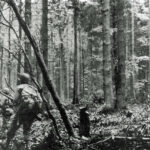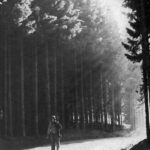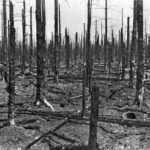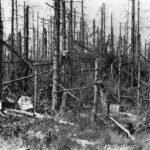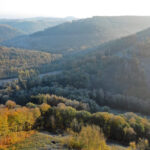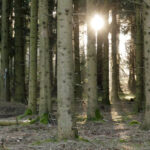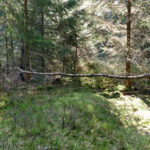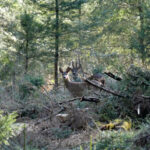Episodes of War: The battered forest (Published on 30/03/2022, updated on 08/06/2022)
Anyone moving through the Hürtgen Forest today sees only shadows of the forest that was the setting for the heavy fighting in the fall and winter of 1944/45. These are the reforested remains of what the war and the repeated forest fires that occurred after its end left of the old tree population that largely made up the Hürtgen Forest before the fighting began.
I. The historical Hürtgen Forest
A good impression of the historical Hürtgen Forest can be taken from the descriptions of Baptist Palm, combat participant and later mayor of Vossenack. In his book “Hürtgenwald – Das Verdun des Zweiten Weltkriegs” [“Hürtgenwald – The Verdun of the Second World War”] from 1953 he also describes in a very vivid way the forest and its changes due to the effects of war. He describes the situation before the war in the following words (ibid., p. 9, translation from German language):
“On the northwestern edge of the Eifel, where one looks down from mountain heights into the lowlands of the Dürener Land, and in the west looks across the border into Belgium, lies the Hürtgen Forest in its majesty, in its tranquility. The Hürtgen Forest, which received its actual name in the German and American military reports, has become known far beyond the borders of our Eifel homeland in the last decade. Whoever knew this forest in the years 1936 and 1937, whoever sought relaxation and peace in the deep, mysterious fir and beech forests, knows what beautiful places of recreation these woods were. Yes, in these forests, where in the beautiful valleys charming streams gave the landscape its peculiar character, where at dusk the deer still sought its grazing on lonely stand edges, in cool stream bottoms, there one could learn to appreciate and love the beauty of the German forest and its silent and secret inhabitants. On the outskirts of this forest were pretty Eifel villages, whose inhabitants, in addition to some agriculture, found work and bread through the forest. These people lived happily and contentedly in these villages and for them this forest, which sometimes reached as far as the house gardens, was a concept. Yes, it was a piece of home. On Sundays, after a week of hard work, when people went to the forest to rest, their faces would show happiness and contentment, and in the peace and quiet they would find a meaning to their lives. Would it stay like that?“
The answer is known.
II. The construction of the Siegfried Line
The first profound disturbance of the described natural idyll was caused by the construction of the Siegfried Line, which crossed the Hürtgen Forest leaving numerous buildings there. Mr Palm explains (ibid., p. 9 f., translation from German language):
“Day and night, trucks heavily loaded with gravel, concrete and iron rolled along the roads. Endless quantities of building materials were brought in. Behind large wooden sheds, people worked day and night, for weeks and months. Gone was the silence, the tranquility in these forests. Everywhere you went, large signs warned you not to enter the area: ‘Security area of the Siegfried Line, verboten, verboten’. The entire forests resembled a large factory. The monotonous grinding of the concrete machines, the hammering of the pneumatic drills, the howling engine noise of the heavily loaded long-distance trucks, the shouting and screaming at the construction sites, the lonely, solemn silence of the forest faded away in all the working noise. Bunkers and positions, impregnable by the standards of the time, grew out of the earth. Dragon’s teeth (tank barriers) stretched for miles through the countryside, through the gardens and meadows of the villages. Wire entanglements blocked the way for hikers in the forests. (…) Strips of forest were cut down in front of the shooting hatches of the bunkers in order to set up firing fields for these structures. The beautiful forest was bleeding from a thousand wounds. Everywhere on the mountain slopes, on the heights and along the roads, gray concrete blocks jutted into the landscape like ghosts.”
III. The fighting in Hürtgen Forest
The first fighting reached the Hürtgen Forest in September 1944. What is remarkable in the accounts of the combat participants is that the German soldiers apparently regarded the forest more as an ally, while the US soldiers often described it – perhaps in retrospect and because of their experiences there – as hostile. An example is provided by the impressions of M. Bedford Davis, deployed with the 28th US Infantry Division in the Hürtgen Forest, who remembers his arrival on the scene as follows (Davis, Frozen Rainbows (2003), p. 193):
“On October 26, 1944, the freshly rested GIs of the U.S. 28th Infantry Division slowly marched into a dark forest. It was a forest out of a German fairy tale – dense, forbidding and hostile. It seemed filled with dark secrets, evil, and the ghosts of the dead. As if the darkness was not enough, it was foggy and damp. One could imagine that a wicked witch might live in its shadows, waiting to snatch some unfortunate soul.”
The forest areas affected by the fighting were completely devastated, especially by the massive use of artillery on both sides. Since the dense forest often made precise target identification impossible, the US side in particular fired indiscriminately into the forest. The shells used for this purpose usually had impact fuses that explode on contact with a solid object. When fired into a forest, this explosion-triggering contact usually takes place with the treetops, so that the artillery shells detonated not on the ground, but already at treetop level. These so-called “tree bursts” not only caused the actual shell fragments to be distributed over a larger area, but the detonation on the tree produced additional wood splinters that were just as dangerous for the soldiers on the ground. In addition, the shells blew off the tops of the trees and the adjacent branches, which fell to the ground and further compacted the already naturally very dense forest, making it almost impenetrable. Mines and booby traps were additionally installed in this thicket.
One can imagine the effects several months of this style of fighting had on the forest. What has become widely known are the pictures from the immediate post-war period, in which the once proud Hürtgen Forest is reduced to no more than charred stumps.
Participating German soldiers sometimes wrote down the fatal effects on the forest during the fighting. One example is Horst Schirmer, who was deployed on the Eifel front in the fall and winter of 1944/45 and described his impressions in his book “Hürtgenwald – Gedichte und Worte um ein Fronterleben” [“Hürtgenwald – Poems and words on a frontline experience”] as follows (ibid., p. 26, translation from German language):
“For a long time, in wind and weather, in cold and storm, I lay in a mud hole at the edge of a forest, and on almost all days – from dawn to evening twilight – a little robin was my only friend and companion. Its small, dark eyes seemed to me so bleak and so full of sorrow for the shattered, death-wounded forest. And I thought: the sorrow of a human being – my sorrow – cannot be greater either.”
The impressions of Bernhard Kramer also seem fitting, although he was not deployed in the Hürtgen Forest, but further south in the Schneifel, where similarly fierce fighting took place in the fall of 1944 under comparable conditions, especially in dense Eifel forest. He writes about the forest there (Kramer, Der Krieg in der Schneifel – September 1944 [“War in the Schneifel – September 1944”] (1996), p. 754 f., translation from German language):
“Shadowy, the ruins of murdered trees reach into the night sky. A tree grows. Man will cut it down one day. The tree dies, but for years to come we can hear its life, when the planks, over which the loud bustle of the day has passed away, crawl and creak in hot nights, and when the ancient chest, which holds the white linen of generations, tells its stories into the silence. A tree is cut down and dies, that is a part of the order. Just as it is part of the order for man to die. But these trees are murdered as a man can be murdered – and that is against the order. And so they stand there, pointing their shattered trunks skyward like a silent lament, or imploringly spreading the mutilated and dead arms of their branches.”
IV. The immediate postwar period
To this devastated and desolate environment, which had once been their home, the fled inhabitants of the villages of the Hürtgen Forest returned after the end of the war. Baptist Palm comments (ibid., p. 106, translation from German language):
“Cursed was the earth of the Hürtgen Forest. The specter of death, hardship and misery rode in the shattered and charred forests, in the fields plowed up by bombs and shells. Everywhere it took its toll. Destroyed was the idyll of the native forests and after decades the traces of the war will still be visible. Even the bird life was extinct. Nowhere could one hear the countless songbirds that used to inhabit the forest and trill their ditties in the most secret and hidden nooks and crannies of the forest. Everywhere was gruesome, eerie silence. American corpse recovery squads picked up the fallen Americans from the battlefields. The Germans remained lying, unburied at their battle sites, in the positions where they had met their fate.”
Nevertheless, this was not the last chapter of the war and its effects on the Hürtgen Forest. As if the war had damaged this former natural idyll so irreparably and permanently that a complete new beginning was the only way out, from the fall of 1945 and until 1948, devastating forest fires repeatedly ravaged the sad remains of the Hürtgen Forest, destroying everything that was still in them. Mr Palm writes (ibid., p. 108, translation from German language):
“The late summer of 1945 came. Everywhere in the woods was the unbearable smell of decay. Nevertheless, nothing was done by higher authorities to bury the soldiers. Then came the terrible thing for the countless survivors who were looking for their dead who lay unburied here: the forests burned! Yes, some circumstance, perhaps it was the piles of ammunition lying around, perhaps it was phosphorus ignited by the heat, had started this fire. Hundreds of acres of forest between Vossenack and Hürtgen were burning. Piles of ammunition of all kinds went up in the air and rekindled the fire again and again. The many hundreds of bodies (no one knows the number) burned and charred. Black bone remains lay scattered wildly on the black, burnt forest floor. Only the black, charred tree stumps rose to the sky, complaining to the world.”
Julius Erasmus also returned to the once idyllic forest area, which enmity and war had turned into a desolate wasteland. Together with his helpers, he set about recovering the dead, identifying them and burying them. The high percentage of unknown soldiers in the military cemeteries in Vossenack and Hürtgen also shows that the battered Hürtgen Forest did not completely release all the soldiers who died in it.
In today’s Hürtgen Forest, trees with rather unusual growth can be found in various places. One example is the tree (remnant) shown in the photo above, in which – depending on perspective and imagination – you can also see a human figure raising its arms with broken branches accusingly towards the sky.
(Head picture: Hürtgen Forest in the Peterberg area, June 2021)
If you wish to support my work on Julius Erasmus, you can do so here. Many thanks!


